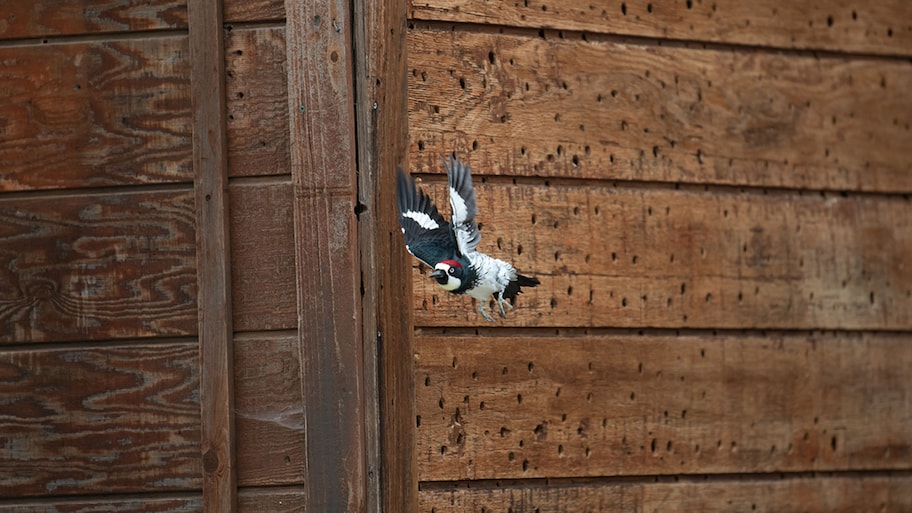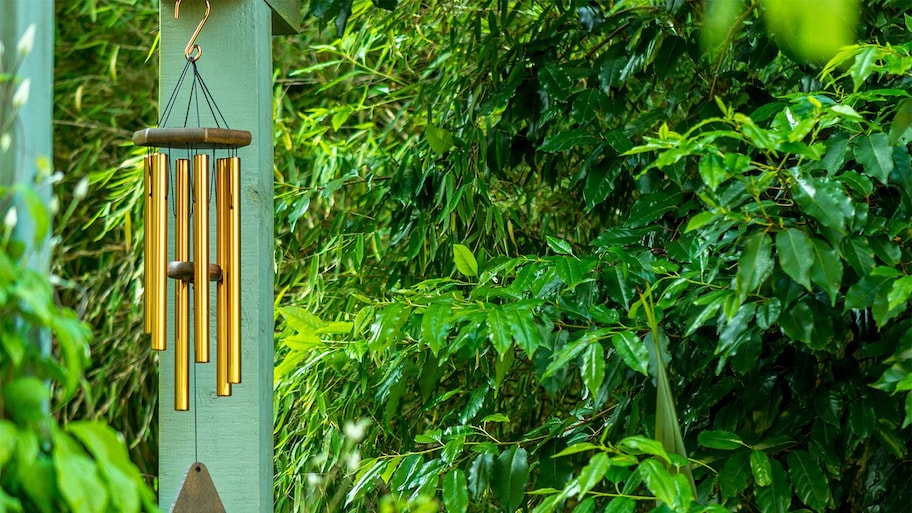Time to move it along, Woody
Woodpeckers help eliminate pests and create nests for other forms of wildlife via the holes they peck in trees. But these federally protected birds don’t discern between a tree or important parts of your home, like the siding or decking, which can leave frustrated homeowners desperate for ways to deal with woodpecker holes.
The best way to get ahead of these problems is to figure out how to get rid of woodpeckers before they wreak havoc on your home. Read on for ways to safely and humanely remove woodpeckers from your property.
Why Do I Have Woodpeckers on My Property?
Like all lifeforms, woodpeckers seek food, shelter, and safety. If your property provides for these basic needs and you live in an area known to house woodpeckers, expect some pointy-beaked visitors. These birds are especially common during their mating season in the spring and have no issue making a nest near your home. Properties with plenty of flora are more likely to attract woodpeckers than bare yards. They're also suckers for wild bird seed and suet, so if you've got feeders in your yard, you're likely familiar with your local woodpeckers.
How Much Does It Cost to Hire a Pro to Remove Woodpeckers
Hiring a pro to remove a bird’s nest costs anywhere from $100 to $2,000, depending on accessibility, the number of specimens using the nest, and any post-removal cleanup services rendered. Woodpeckers fall on the low-to-medium end of that price range, as they don’t travel in large flocks like pigeons and other species.
How to Identify Woodpeckers Near Your Home

You can listen for the telltale sound of near-constant pecking to pin down the location of nests, as woodpeckers won’t stray too far from home when searching for food. You can spot woodpeckers by looking out for their black-feathered bodies with white patches and a red crest atop their heads, though plumage and field markings vary by type.
Finally, look out for woodpecker holes. These are present anywhere the woodpeckers search for food or shelter. There are three types of woodpecker holes.
Foraging holes: These are small, deep holes that are visible in a straight vertical or horizontal line. Newer wood fixtures feature fewer foraging holes than older wood.
Drumming holes: These holes are typically caused by male woodpeckers looking to “drum” up a mate. Look for many small, shallow holes in a cluster.
Roosting holes: Otherwise known as nesting holes or excavation holes, these are much larger than the other types. Roosting holes are fairly large in diameter, up to five centimeters, and sometimes resemble an upside-down L, with an additional protrusion on the side.
What Damage Do Woodpeckers Cause?
These birds peck anything they get their beaks on, but particularly wood. That means your wood siding, fences, decking, and utility poles, are all at risk for woodpecker damage. Though these holes start small, they accrue serious cosmetic damage over time. Additionally, woodpeckers eventually open up entry points into your home, leading to invasive species, leaks, mold growth, and other problems. Though they rely exclusively on wood, these birds accidentally pierce plumbing and electrical lines while foraging or building a nest.
It is worth noting, however, that woodpeckers much prefer dead trees to anything on your property.
How to Get Rid of Woodpeckers With 5 Methods

These methods are all fairly simple and fall into two categories—scaring them off, and removing their resources. There are processes to shoo away woodpeckers, allowing you to remove or fill in the nests later, and those that cut off food and shelter sources, encouraging them to move on to another area. Just a reminder, it is illegal to kill, harm, or trap a woodpecker, as they are protected by the federal North American Migratory Bird Act. This also goes for nests, so don’t remove active nests, though stagnant nests are fine to remove.
Before attempting any of these procedures, perform due diligence to find the location of woodpecker nests on your property.
1. Use Reflective Foil Tape
Use reflective foil tape around your property to frighten woodpeckers away. Owl statues and the like work for a little while, but woodpeckers quickly realize that these structures are not actual predators. Aluminum foil also works in a pinch, though hardware stores and online retailers sell it in tape form.
You should hang the reflective foil around the epicenter of your woodpecker problem via strings. Start small and test over a few days, adding more tape as needed. How does this work? The wind pushes the foil tape around and the reflective surface creates the illusion of movement in the trees.
2. Hang Wind Chimes and Pinwheels
Wind chimes provide sudden noise and pinwheels bring unpredictable movement, both of which scare off woodpeckers. Locate the epicenter of your woodpecker problem and hang as many wind chimes and pinwheels as you can. Wait a few days to see if your problem lessens. If not, hang more chimes and wheels or move on to the next method.
3. Set Up Motion-Activated Speakers
If the noise produced by your wind chimes was too subtle to scare off woodpeckers, go with a louder solution. There are many motion-activated noise makers or speakers available for purchase online and at local hardware stores. Hang these devices wherever the woodpeckers hang out and let them do their magic over a few days. If the birds become accustomed to the noise, try a different noisemaker or even a different setting.
4. Use Netting
Bird netting is a simple way to protect any area affected by woodpeckers. Simply cast a large swath of netting near the problem area, encouraging woodpeckers to move on to less frustrating locations. As a note, avoid repellants designed to coat structures with a sticky surface. Though effective, as woodpeckers dislike the resulting experience, these repellants damage your roof, siding, and other permanent fixtures.
5. Wrap Trees With Burlap
Woodpeckers prefer trees over exterior walls, siding, roofs, and other manufactured structures.
If you notice that woodpeckers are sticking to your trees, poking many holes for foraging, nesting, and attracting mates, consider wrapping them in burlap bags or sacks. These bags are inexpensive and easy to apply. Just wrap up the tree as you see fit, as woodpeckers rarely peck through the burlap.
6 Ways to Deter Woodpeckers From Coming Back

Once woodpeckers flee your property in search of greener pastures, you can deter future visitors by following these methods.
1. Fill Holes
Use epoxy putty to fill in the holes caused by the woodpeckers as they searched for food, built nests, or tempted mates. Wood putty also works for this task. Woodpeckers return to the same areas each year during migration, so keeping these holes filled acts as a major deterrence.
2. Conduct Necessary Repairs
Woodpeckers cause serious damage to roof shingles and siding, necessitating repairs. Replace the shingles and fix the siding as recommended by a contractor, as these imperfections act as nests for returning birds next season.
3. Have Your Trees Inspected
Woodpeckers primarily love dying and diseased trees. In other words, an abundance of woodpeckers could indicate something is wrong with the health of the trees on your property. Conduct a professional tree inspection with a local arborist to suss out any issues.
4. Handle Pest Problems
Woodpeckers love to eat carpenter ants, termites, grubs, and any other insect they come across. If woodpeckers are drawn to your home, it could indicate a pest infestation problem. Hire an exterminator to remove their favorite food sources.
5. Paint Wood Siding
If woodpeckers choose your wood siding as a nesting spot, paint the siding once they leave, as studies indicate that paint fills in gaps that house pests, thus discouraging predators. On the other hand, sealing your wood siding attracts woodpeckers.
6. Install Nest Boxes
If you do everything and woodpeckers still visit each and every year, give them somewhere else to live instead of in your siding or your trees. Place cavity-type nest boxes throughout your property, staying close to the epicenter of damage. Fill these boxes with sawdust to encourage the birds to excavate and make a new home.
DIY vs. Hiring a Pro
The above steps cater to DIYers and are easily accomplished by both seasoned homeowners and amateur renovators. However, if these simple deterrence procedures do nothing to alleviate the problem, bring in a local bird control company to help. They are experienced in locating and deterring active woodpecker populations in residential areas. These pros charge a rate of $50 to $250 per hour, depending on the level of expertise.
FAQs
What time of day do woodpeckers peck?
Woodpeckers peck at the break of dawn and take a break whenever the sun is not shining. On sunny days, expect pecking from dawn to dusk. On cloudy days, expect sporadic pecking when the sun peeks through.
Do woodpeckers come back to the same spot?
It depends on the species. Some woodpeckers nest in the same spot, year after year, as long as it is available. Other species, like downy woodpeckers and hairy woodpeckers, excavate new nests each year.
How long does it take for a woodpecker to make a hole?
Woodpeckers create foraging or drumming holes in mere seconds, but roosting holes take much longer. An average woodpecker digs out the proper-sized cavity for nesting in around 12 to 17 days.





